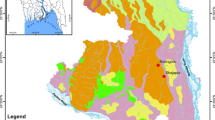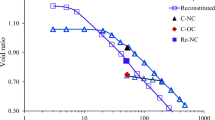Abstract
Owing to bond structure forming through depositional history and aging, natural sedimentary soils behave differently, in comparison to their reconstituted/destructured counterparts. Herein, consolidation behaviors of high-quality undisturbed and completely reconstituted samples of a fine alluvial clayey soil from Shiraz are studied. Experimental findings elucidate the impact of bond structure on virgin oedometric consolidation of undisturbed clayey samples, in so far as void ratio for such soils experiences insignificant change at vertical effective stresses lower than yield stress (about 105 kPa). Nevertheless, beyond the yield stress, structured specimens exhibit a rapid change in void ratio with vertical effective stress, in comparison to that of the completely reconstituted ones. Finally, with extensive bonding destructuration under elevated normal effective stress, disparity between normal consolidation curves of initially structured and fully reconstituted specimens becomes negligible. It is shown that evolution of void ratio with vertical effective stress for Shiraz structured fine soil can be reasonably simulated using constitutive equations reported in the literature.












Similar content being viewed by others
Abbreviations
- A:
-
Activity (see Table 1)
- B:
-
Soil parameter (see Eq. 4)
- e:
-
Void ratio of structured soil
- e*:
-
Void ratio of completely reconstituted soil on normal consolidation line
- e0*:
-
e* at \(\sigma _{v}^{'}\) = pref on normal consolidation line (see Eq. 2)
- eκ*:
-
e* at \(\sigma _{v}^{'}\)= pref on the idealized unloading/reloading line (see Eq. 6)
- Gs :
-
Specific gravity of solid phase (=ρs/ρw)
- pref :
-
Reference pressure (=101 kPa)
- Sv :
-
Soil parameter (see Eq. 3)
- w:
-
Water content
- wN :
-
Natural water content (see Table 1)
- wopt :
-
Optimum water content (see Table 1)
- ∆e:
-
Difference between void ratios of the structured and reconstituted soils
- ∆ei :
-
∆ei is ∆e at \(\sigma _{v}^{\prime}={{(\sigma _{v}^{\prime})}_{\text {yield}}}\) (see Eq. 4)
- κ:
-
Slope of the unloading/reloading line in the e vs. ln \(\sigma _{v}^{'}\) plane for structured specimens
- κ*:
-
Slope of the unloading/reloading line in the e* vs. ln \(\sigma _{v}^{'}\) plane for reconstituted specimens
- λ*:
-
Slope of normal consolidation line in the e* vs. ln \(\sigma _{v}^{'}\) plane
- ρd :
-
Soil dry density
- ρs :
-
Average density of soil solid phase
- ρw :
-
Density of water (= 1000 kg/m3)
- \(\sigma _{v}^{'}\) :
-
Vertical effective stress
- \({{(\sigma _{v}^{'})}_{\text {yield}}}\) :
-
Vertical effective stress at yield
References
Mitchell JK, Soga K (2005) Fundamentals of soil behavior. Wiley, New Jersey
Shibuya S (2000) Assessing structure of a aged natural sedimentary clays. Soils Found 40(3):1–16
Suebsunk J, Horpibulsuk S, Liu MD (2010) Modified Structured Cam Clay: A generalized critical state model for destructured, naturally structured and artificially structured clays. Comput Geotech 37(7–8):956–968
Burland JB (1990) On the compressibility and shear strength of natural clays. Géotechnique 40(3):329–378
Leroueil S, Vaughan PR (1990) The general and congruent effects of structure in natural soils and weak rocks. Géotechnique 40(3):467–488
Liu MD, Carter JP (1999) Virgin compression of structured soils. Géotechnique 49(1):43–57
Liu MD, Carter JP (2002) A structured Cam Clay model. Can Geotech J 39:1313–1332
Shibuya S, Li D, Noda T, Nakano H (2005) Mechanical behavior of structured clay and its simulation. In: Geomechanics: Testing, Modeling, and Simulation, vol 143. ASCE Geotechnical Special Publication, pp 286–306
Park, D.S., and Kutter, B.L. (2016). Sensitive bounding surface constitutive model for structured clay. Int J Num Anal Methods Geomech, 40(14), 1968–1987
Liu E, Wang S, Zhou C, Nie Q (2016) Mechanical properties of artificial structured soils under a conventional drained loading-unloading-reloading stress path. Int J Civil Eng. doi:10.1007/s40999-016-0133-z (in press)
Roscoe KH, Burland JB (1968) On the generalized stress-strain behavior of “wet clay”. Engineering Plasticity. Eds. J Heyman, Leckie .pbl Cambridge University Press, USA
Schofield AN, Wroth CP (1968) Critical state soil mechanics. McGraw-Hill, London
Muir Wood D (1990) Soil behavior and critical state soil mechanics. Cambridge University Press, USA
Dafalias YF (1986) An anisotropic critical state soil plasticity model. Mech Res Commun 13(6):341–347
Newson TA, Davies MCR (1996) A rotational hardening constitutive model for anisotropically consolidated clay. Soils Found 36(3):13–20
Ling HI, Yue D, Kaliakin VN, Themelis NJ (2002) Anisotropic elastoplastic bounding surface model for cohesive soils. ASCE. J Eng Mech 128(7):748–758
Karstunen M, Wiltafsky C, Krenn H, Scharinger F, Schweiger, HF (2006) Modeling the behavior of an embankment on soft clay with different constitutive models. Int J Num Anal Methods Geomech 30(10):953–982
Dafalias YF, Manzari MT, Papadimitriou AG (2006) SANICLAY: simple anisotropic clay plasticity model. Int J Num Anal Methods Geomech 30(12):1231–1257
Huang W-X, Wu W, Sun D-A, Sloan S (2006) A simple hypoplastic model for normally consolidated clay. Acta Geotech 1(1):15–27
Yildiz A, Uysal F (2016) Modeling of anisotropy and consolidation effect on behavior of sunshine embankment: Australia. Int J Civil Eng 14(2):83–95. doi:10.1007/s40999-016-0018-1
Hu R, Liu H-H, Chen Y, Zhou C, Gallipoli D (2014) A constitutive model for unsaturated soils with considering of inter-particle bonding. Comput Geotech 59:127–144
Lashkari A, Mahboubi M (2015) Use of hyper-elasticity in anisotropic clay plasticity models. Scientia Iranica 22(5):1643–1660
Chen J (2016) A monotonic bounding surface critical state model for clays. Acta Geotech. doi:10.1007/s11440-016-0439-7
Ling HI, Hung C, Kaliakin VN (2016) Application of an enhanced anisotropic bounding surface model in simulating deep excavations in clays. ASCE J Geotech Geoenv Eng: doi:10.1061/(ASCE)GT.1953-5606.0001533
Sivasithamparam N, Castro J (2016) An anisotropic elastoplastic model for soft clays based on logarithmic contractancy. Int J Num Anal Methods Geomech 40(4):596–621
Kavvadas M, Amorosi A (2000) A constitutive model for structured soils. Géotechnique 50(3):263–273
Rocchi G, Vaciago G, Fontana M, Da Prat M (2013) Understanding sampling disturbance and behaviour of structured clays through constitutive modeling. Soils Found 53(2):315–334
Leroueil S, Tavenas F, Brucy F, La Rochelle P, Roy M (1979) Behaviour of destructured natural clays. ASCE J Geotech Eng Div, 105(6):759–778
Wang D, Zentar R, Abriak NE (2016) Interpretation of compression behavior of structured and remolded marine soils. ASCE J Mat Civil Eng, doi:10.1061/(ASCE)MT.1943-5533.0001503
Qian S, Shi J, Ding J–W (2016) Modified Liu-Carter compression model for natural clays with various initial water contents. Adv Civil Eng, Article ID 1691605
ASTM D4318-10e1 (2010) Standard Test Methods for Liquid Limit, Plastic Limit, and Plasticity Index of Soils, ASTM International, West Conshohocke
ASTM D2487-11 (2011) Standard Practice for Classification of Soils for Engineering Purposes (Unified Soil Classification System), ASTM International, West Conshohocken.
ASTM D2216-10 (2010) Standard Test Methods for Laboratory Determination of Water (Moisture) Content of Soil and Rock by Mass, ASTM International, West Conshohocken
ASTM C128-15 (2015) Standard Test Method for Relative Density (Specific Gravity) and Absorption of Fine Aggregate, ASTM International, West Conshohocken.
ASTM D698-12e2 (2012) Standard Test Methods for Laboratory Compaction Characteristics of Soil Using Standard Effort (12 400 ft-lbf/ft3 (600 kN-m/m3)), ASTM International, West Conshohocken, PA
ASTM D2435 / D2435M-11 (2011) Standard Test Methods for One-Dimensional Consolidation Properties of Soils Using Incremental Loading, ASTM International, West Conshohocken
Hong Z–S, Yin J, Cui Y–J (2010) Compression behavior of reconstituted soils at high initial water contents. Géotechnique 60(9):691–700
Acknowledgements
The constructive comments, both technical and editorial, by the anonymous reviewers are gratefully acknowledged. The assistance of Mr. Benyamin Farhadi in preparation of SEM photographs is appreciated. Also, the authors would like to express their gratitude to Mr. Hossein Yazdanpanah Faragheh and Mr. Mohammad Rahimpoor for their assistance in obtaining high quality soil samples.
Author information
Authors and Affiliations
Corresponding author
Ethics declarations
Funding
No funding information was available.
Rights and permissions
About this article
Cite this article
Memarzadeh, I., Lashkari, A. & Shourijeh, P.T. Consolidation Behavior of Structured Clayey Soils: A Case Study on Shiraz Fine Alluvial Strata. Int J Civ Eng 16, 1435–1444 (2018). https://doi.org/10.1007/s40999-017-0163-1
Received:
Revised:
Accepted:
Published:
Issue Date:
DOI: https://doi.org/10.1007/s40999-017-0163-1




